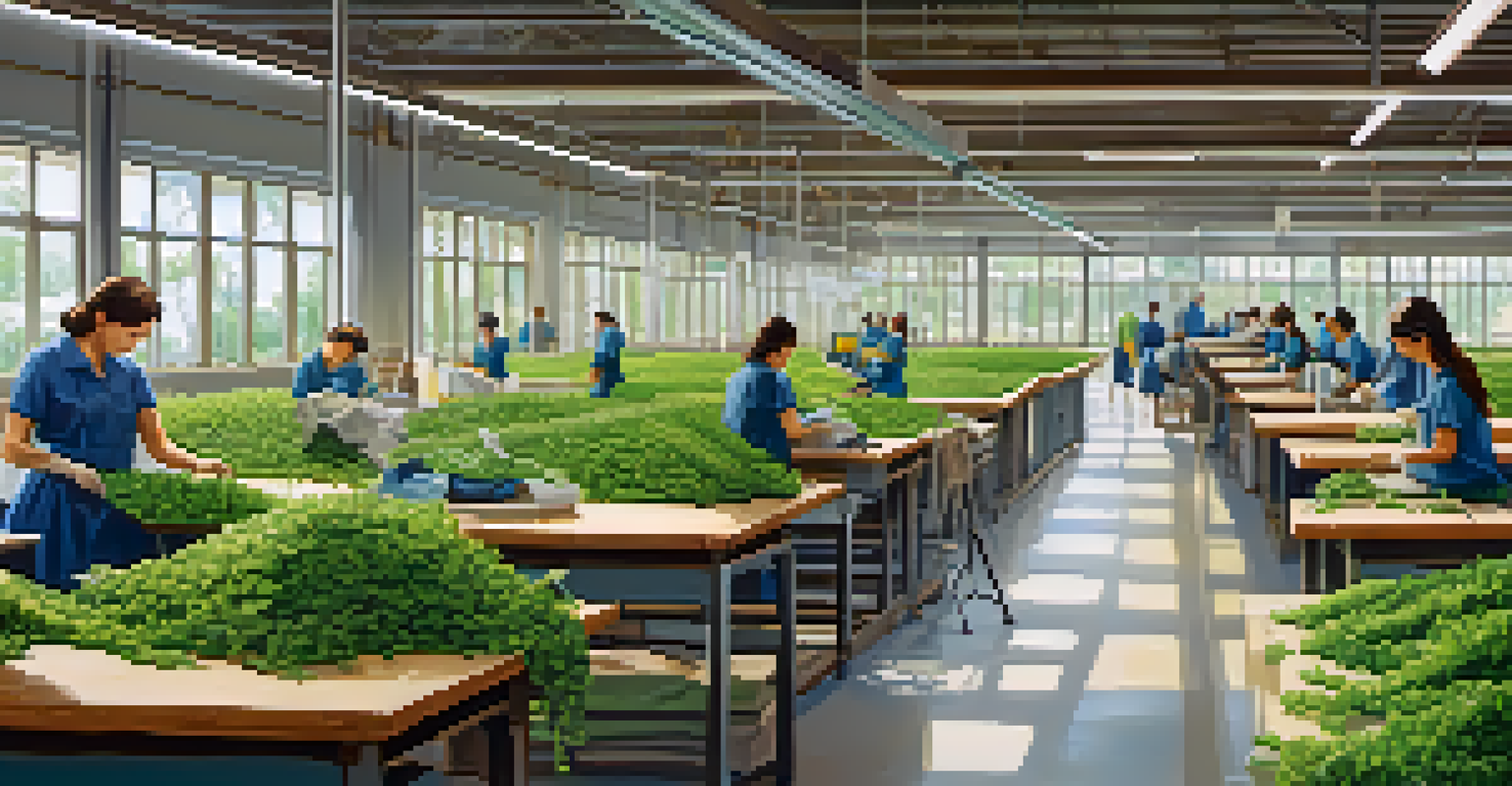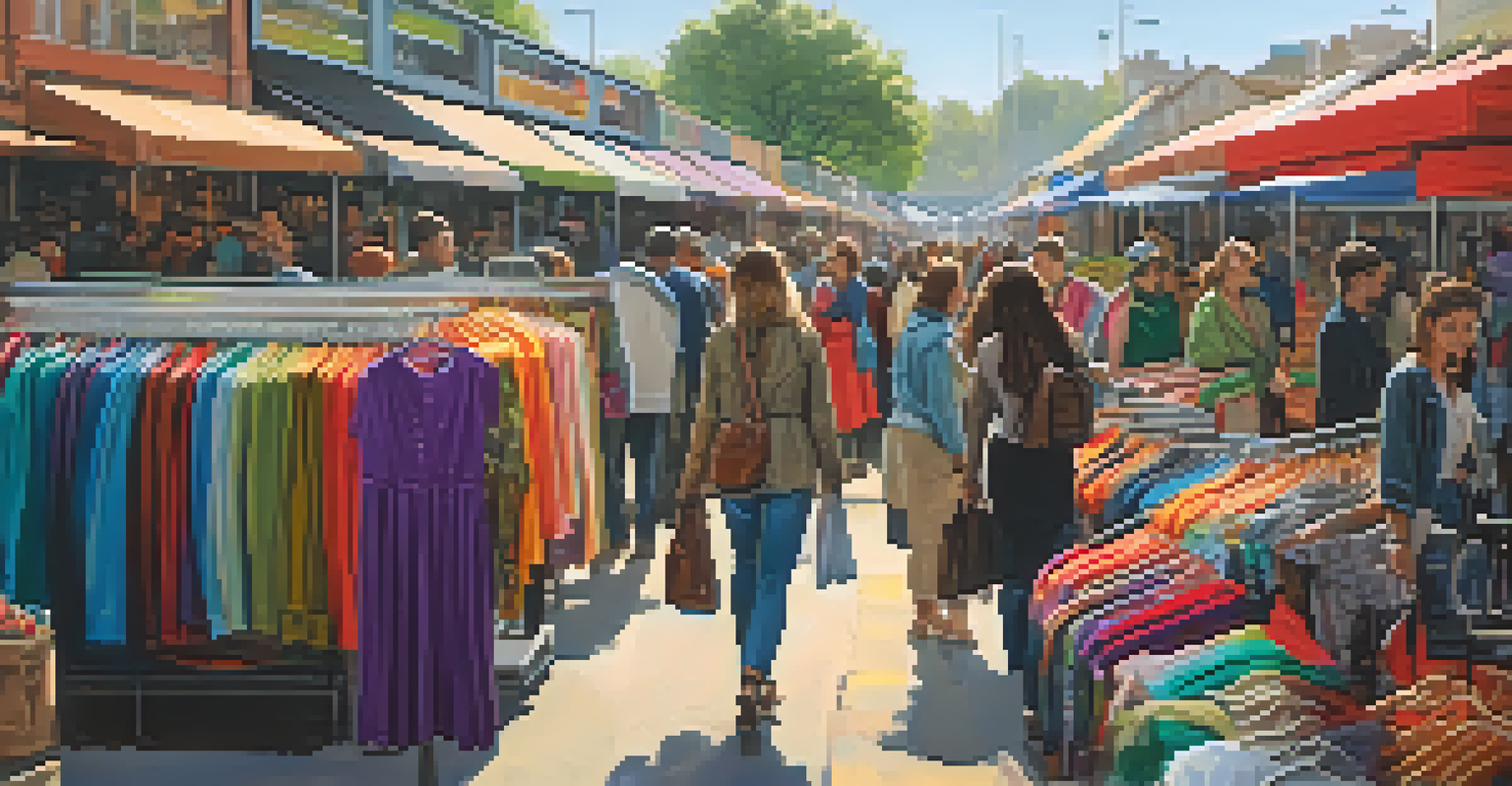The Lifecycle of Fashion: From Production to Disposal

Understanding the Fashion Lifecycle: An Overview
The fashion lifecycle is a fascinating journey that every garment follows, starting from production and ending with disposal. This cycle encompasses various stages, including design, manufacturing, distribution, consumption, and ultimately disposal. Understanding this lifecycle is essential for both consumers and industry professionals to make informed choices about sustainability and ethical practices. By grasping the entire process, we can appreciate the impact our fashion decisions make on the environment.
Fashion is the armor to survive the reality of everyday life.
Each phase of the lifecycle is interconnected, much like the links in a chain. When one link is weakened—say, through fast fashion—it affects the entire system, leading to negative consequences like waste and pollution. This interconnectedness emphasizes the importance of considering not just what we wear but how it was made and what happens to it afterward. As consumers, being aware of the lifecycle can empower us to promote more sustainable practices.
In this article, we will delve deeper into each stage of the fashion lifecycle, examining how clothes are created, how they are used, and what ultimately happens when they are no longer wanted. By understanding these phases, we can all contribute to a more sustainable future in fashion.
Stage 1: Design - The Spark of Creativity
Every fashion item begins its life in the design stage, where creativity takes center stage. Designers draw inspiration from various sources like art, culture, and current trends to create unique garments. This phase is crucial, as it sets the tone for the entire lifecycle, influencing everything from fabric choices to manufacturing methods. A well-thought-out design can lead to a more sustainable product by prioritizing durability and timelessness.

Designers are increasingly incorporating sustainable practices into their work, such as using eco-friendly materials and ethical sourcing. This shift not only appeals to environmentally conscious consumers but also helps reduce the industry's overall footprint. Moreover, innovative technologies, like 3D printing and digital design, are paving the way for more sustainable practices in the design phase.
Fashion Lifecycle Impacts Sustainability
Understanding the fashion lifecycle helps consumers and industry professionals make informed choices that promote sustainability and ethical practices.
Ultimately, the design stage is where the vision of a garment begins to take shape. It's a blend of creativity and responsibility, setting the foundation for a product that can impact the environment and society positively or negatively.
Stage 2: Production - From Concept to Reality
Once a design is finalized, the next step is production, where garments come to life. This phase involves sourcing materials, cutting, sewing, and finishing the clothing items. The production stage can vary significantly in terms of environmental impact, depending on the methods and materials used. For instance, conventional cotton farming can be water-intensive, while organic cotton has a lesser impact on the environment.
Sustainability is no longer a choice; it is a necessity.
In recent years, many brands have begun to embrace more sustainable practices during production, such as using recycled fabrics or implementing waste-reduction strategies. These changes can significantly lower the environmental footprint of a garment. Additionally, ethical labor practices are becoming a priority, ensuring that workers are treated fairly and work in safe conditions.
The choices made during the production stage ripple through the entire lifecycle. By opting for sustainable and ethical production methods, brands can contribute to a more responsible fashion industry, ultimately benefiting both the environment and society.
Stage 3: Distribution - Getting Fashion to the Consumer
After production, the next stage is distribution, where garments are transported from factories to stores or consumers. This phase is often overlooked, but it plays a crucial role in the overall sustainability of the fashion lifecycle. Transportation methods, packaging, and supply chain efficiency all impact the carbon footprint associated with a garment. For instance, shipping products via air freight can significantly increase emissions compared to ocean freight.
Many brands are exploring innovative distribution strategies to minimize their environmental impact. For example, some are adopting local production models or utilizing technology to streamline logistics and reduce waste. Additionally, the rise of e-commerce has led to an increase in direct-to-consumer sales, which can potentially reduce the carbon footprint by eliminating middlemen.
Design Sets the Sustainability Tone
The design phase is crucial for creating sustainable garments, as it influences fabric choices and manufacturing methods.
Ultimately, the distribution stage is about connecting consumers with the fashion they desire while being mindful of the environmental implications. By prioritizing sustainable logistics and distribution practices, the fashion industry can move towards a greener future.
Stage 4: Consumption - The Wear and Tear of Fashion
Once garments reach consumers, the consumption phase begins, and this is where personal choices come into play. How we care for, wear, and ultimately dispose of our clothing can significantly impact the lifecycle of fashion. For example, washing clothes in cold water and air drying can reduce energy usage and extend a garment's lifespan. Additionally, buying high-quality pieces that last longer can help reduce the demand for fast fashion.
Consumer behavior also influences fashion trends, often dictating what items are in demand. The rise of social media and influencer culture has accelerated trends, leading to quicker consumption and, unfortunately, increased waste. Understanding the environmental impact of our fashion choices can inspire us to make more conscious decisions, such as supporting sustainable brands or choosing second-hand options.
The consumption stage is a pivotal moment in the fashion lifecycle, and it highlights the power of individual choices. By embracing mindful consumption, we can contribute to a more sustainable future and help shift the fashion industry towards practices that prioritize the planet.
Stage 5: Care - Maintaining Fashion Sustainability
The way we care for our clothing directly affects its lifespan and sustainability. Proper maintenance can reduce the frequency with which garments need to be replaced, ultimately minimizing waste. Simple actions like following washing instructions, repairing minor damages, and storing clothes appropriately can extend a garment's life significantly. This stage often gets overlooked, but it plays a crucial role in reducing the environmental impact of fashion.
In recent years, there has been a growing movement towards educating consumers on clothing care. Many brands are now providing detailed care instructions and promoting repair services to encourage customers to take better care of their garments. This shift not only benefits the environment but also fosters a deeper connection between consumers and their clothing.
Mindful Consumption Reduces Waste
How we care for, wear, and dispose of clothing significantly impacts the fashion lifecycle, making mindful consumption essential for sustainability.
By prioritizing care, we can ensure that the garments we invest in last longer, ultimately contributing to a more sustainable fashion lifecycle. It's a small effort that can lead to significant changes in how we view and interact with our clothing.
Stage 6: Disposal - The End of the Line or a New Beginning?
The final stage in the fashion lifecycle is disposal, which often raises questions about sustainability and waste management. Unfortunately, a significant amount of clothing ends up in landfills, contributing to pollution and greenhouse gas emissions. This highlights the importance of considering what happens to our clothing at the end of its life. Many garments can be recycled, repurposed, or donated instead of being thrown away.
Increasingly, brands are implementing take-back programs, allowing consumers to return unwanted clothing for recycling or resale. This not only reduces waste but also promotes a circular economy, where materials are continuously reused rather than discarded. The rise of second-hand shopping and clothing swaps are also gaining popularity, allowing consumers to give their garments a second life.

Disposal doesn't have to mean the end of a garment's journey. By choosing sustainable disposal options, we can significantly reduce the environmental impact of fashion and contribute to a more responsible future.
Moving Towards a Sustainable Fashion Future
The lifecycle of fashion is a complex journey filled with numerous opportunities for improvement. By understanding each stage, we can identify areas where we can make impactful changes, whether as consumers or industry professionals. Sustainable fashion is not just a trend; it's a necessary shift towards a more responsible and ethical industry that values both people and the planet.
As we embrace sustainability, collaboration among brands, consumers, and policymakers becomes crucial. By working together, we can create a fashion system that prioritizes eco-friendly practices and ethical labor standards. Education plays a significant role as well, empowering consumers to make informed choices and advocate for change within the industry.
Ultimately, the future of fashion depends on our collective actions and choices. By committing to a more sustainable lifecycle, we can pave the way for a thriving fashion industry that respects the environment and contributes positively to society.